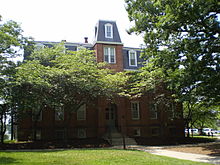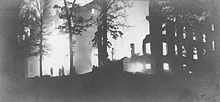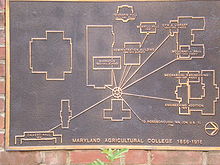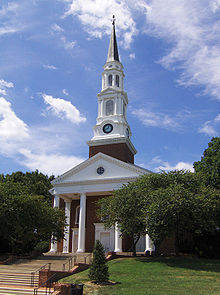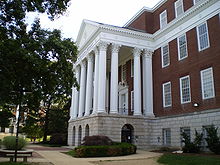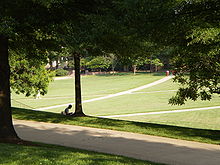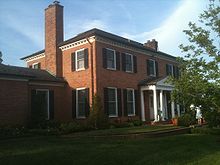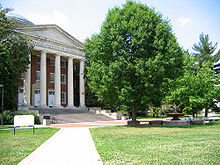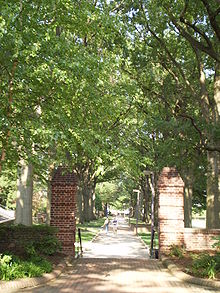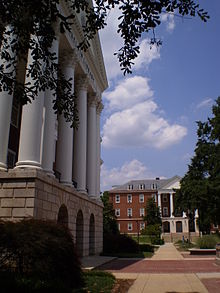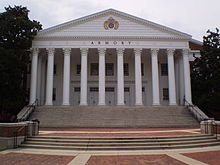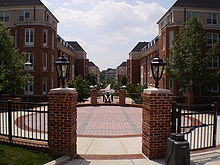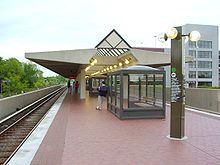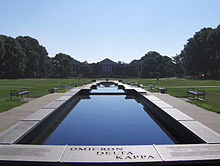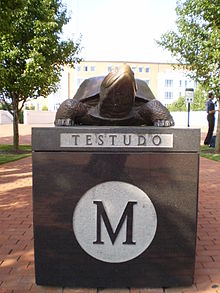- University of Maryland, College Park
-
"University of Maryland" redirects here. For other uses, see University of Maryland (disambiguation).
Coordinates: 38°59′15.0″N 76°56′24.0″W / 38.9875°N 76.94°W
University of Maryland,
College Park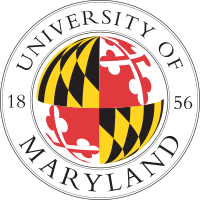
Motto Fatti maschii, parole femine[1] (Italian) Motto in English Strong deeds, Gentle words[2] Established 1856 Type Flagship Public university, Land-Grant, Space-Grant, Sea-Grant Endowment $672 million (as of 2010)[3] President Wallace Loh[4][5] Provost Ann G. Wylie[6] Academic staff 3,996[7] Admin. staff 5,116[7] Students 37,641[7] Undergraduates 26,922[7] Postgraduates 10,719[7] Location College Park, Maryland, United States
38°59′17″N 76°56′41″W / 38.98806°N 76.94472°WCampus Suburban, 1,250 acres (5.1 km2)[7] Colors Red, White, Black, and Gold Athletics NCAA Division I[7] Nickname Terrapins, Terps Mascot Testudo Affiliations ACC, AAU, MAISA, Fields Institute, Consortium of Universities of the Washington Metropolitan Area Website http://www.umd.edu 
The University of Maryland, College Park (often referred to as The University of Maryland, UM, UMD, UMCP, or Maryland) is a top-ranked public research university located in the city of College Park in Prince George's County, Maryland, United States, just outside Washington, D.C. Founded in 1856, the University of Maryland is the flagship institution of the University System of Maryland. With a fall 2010 enrollment of more than 37,000 students, over 100 undergraduate majors and 120 graduate programs, Maryland is the largest university in the state and the largest in the Washington Metropolitan Area.[7][8] It is a member of the Association of American Universities and a founding member of the Atlantic Coast Conference athletic league.
The University of Maryland's proximity to the nation's capital has resulted in strong research partnerships with the Federal government. Many members of the faculty receive research funding and institutional support from agencies such as the National Institutes of Health, the National Aeronautics and Space Administration (NASA), the National Institute of Standards and Technology and the Department of Homeland Security.
As of fiscal year 2009, the University of Maryland, College Park's operating budget was projected to be approximately $1.531 billion.[9] For the same fiscal year, the University of Maryland received a total of $518 million in research funding, surpassing its 2008 mark by $117 million.[10] As of June 30th, 2011, the university's "Great Expectations" campaign had exceeded $850 million in private donations.[11]
Contents
History
Early history
On March 6, 1856, the forerunner of today's University of Maryland was chartered as the Maryland Agricultural College (1856-1916). Two years later, Charles Benedict Calvert, a descendant of the Barons Baltimore, fervent believer in agricultural education, and a future U.S. Congressman, purchased 420 acres (1.7 km2) of the Riverdale Plantation in College Park for $21,000. Calvert founded the school later that year with money earned by the sale of stock certificates. On October 5, 1859, the first 34 students entered the Maryland Agricultural College, including four of Charles Calvert's sons, George, Charles, William and Eugene. The keynote speaker on opening day was Joseph Henry, the first Secretary of the Smithsonian Institution.[12]
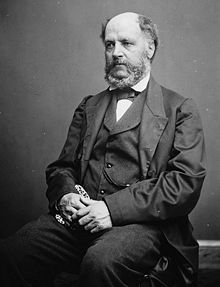 Charles Benedict Calvert, founder
Charles Benedict Calvert, founder
In July 1862, the same month that the Maryland Agricultural College awarded its first degrees, President Lincoln signed the Morrill Land Grant Act.[13] The legislation provided federal funds to schools that taught agriculture or engineering, or provided military training. Taking advantage of the opportunity, the school became a land grant college in February 1864 after the Maryland legislature voted to approve the Morrill Act.[12]
Civil War
A few months after accepting the grant, the Maryland Agricultural College proved to be an important site in the Civil War. In April 1864, General Ambrose E. Burnside and 6,000 soldiers of the Union's Ninth Army Corps camped on the MAC campus. The troops were en route to reinforce General Ulysses S. Grant's forces in Virginia.[14]
Later that summer, around 400 Confederate soldiers led by General Bradley T. Johnson stayed on the grounds while preparing to take part in a raid against Washington. In local legend, it is told that the soldiers were warmly welcomed by university President Henry Onderdonk, a Confederate sympathizer, and that the cavalrymen were thrown a party on the campus nicknamed "The Old South Ball." The next morning the soldiers rode off to cut the lines of communication between Washington and Baltimore.[15]
Financial problems forced the increasingly desperate administrators to sell off 200 acres (81 ha) of land, and the continuing decline in student enrollment sent the Maryland Agricultural College into bankruptcy. For the next two years the campus was used as a boys preparatory school.[12]
Morrill Hall, built in 1898, is the oldest academic building on campus.
Following the Civil War, the Maryland legislature pulled the college out of bankruptcy, and in February 1866 assumed half ownership of the school. The college thus became in part a state institution. George Washington Custis Lee, son of Confederate General Robert E. Lee, was appointed president of the college by the Board of Trustees, but due to public outcry declined the position. By October 1867, the school reopened with 11 students. In the next six years, enrollment continued to grow, and the school's debt was finally paid off. Twenty years later, the school's reputation as a research institution began, as the federally funded Agricultural Experiment Station was established there. During the same period, a number of state laws granted the college regulatory powers in several areas—including controlling farm disease, inspecting feed, establishing a state weather bureau and geological survey, and housing the board of forestry.[12] In 1888, the college began its first official intercollegiate baseball games against rivals St. John's College and the United States Naval Academy. Baseball, however, had been played at the college for decades before the first "official" games were recorded. The first fraternity at Maryland, Phi Sigma Kappa, was established in 1897, and Morrill Hall (the oldest instructional building still in use on campus) was built the following year.[12]
The Great Fire of 1912
On November 29, 1912, around 10:30 p.m., a fire, probably due to faulty electric wiring, broke out in the attic of the newest administration building, where a Thanksgiving dance was being held. The approximately eighty students on the premises evacuated themselves safely, and then formed a makeshift bucket brigade. The fire departments summoned from nearby Hyattsville and Washington, D.C. arrived too late. Fanned by a strong southwest wind, the fire destroyed the barracks where the students were housed, all the school's records, and most of the academic buildings, leaving only Morrill Hall untouched. The loss was estimated at $250,000 (about $5.5 million in 2007 U.S. dollars) despite no injuries or fatalities. The devastation was so great that many never expected the university to reopen. University President Richard Silvester resigned, brokenhearted.[12] However, the students refused to give up. All but two returned to the university after the break and insisted on classes continuing as usual. Students were housed by families in neighboring towns who were compensated by the university until housing could be rebuilt, although a new administration building was not built until the 1940s.[12]
A large brick and concrete compass inlaid in the ground designates the former center of campus as it existed in 1912. Lines engraved in the compass point to each building that was destroyed in the Thanksgiving Day fire. The only building not marked on the compass is Morrill Hall, which was spared by the blaze. The intersection of the lines on the compass are known as "The Point of Failure" and a plaque nearby warns students of the danger that if you step on this point you will not graduate in four years.
Modern history
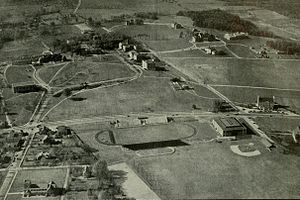 The University of Maryland campus as it appeared in 1938 before the dramatic expansion engineered by President Byrd
The University of Maryland campus as it appeared in 1938 before the dramatic expansion engineered by President Byrd
The state took complete control of the school in 1916, and consequently the institution was renamed Maryland State College (1916-1920). Also that year, the first female students enrolled at the school. On April 9, 1920, the college merged with the established professional schools in Baltimore to form the University of Maryland (1920-Present). The graduate school on the College Park campus awarded its first Ph.D. degrees, and the University's enrollment reached 500 students in the same year. In 1925 the University was accredited by the Association of American Universities.[12]
During World War II, Maryland was one of 131 colleges and universities nationally that took part in the V-12 Navy College Training Program which offered students a path to a Navy commission.[16]
By the time the first black students enrolled at the University in 1951, enrollment had grown to nearly 10,000 students—4,000 of whom were women. Prior to 1951, many black students in Maryland were enrolled at the University of Maryland, Eastern Shore which was almost shut down in 1947 due to lack of access, low quality education, and the fear among some black and white leaders that Eastern Shore was allowed to remain a college by the Regents of the University of Maryland solely to keep black students in segregated, inferior institutions.[17]
In 1957 President Wilson H. Elkins made a push to increase academic standards at the University. His efforts resulted in the creation of one of the first Academic Probation Plans. The first year the plan went into effect, 1,550 students (18% of the total student body) faced expulsion. Since then, academic standards at the school have steadily risen. Recognizing the improvement in academics, Phi Beta Kappa established a chapter at the university in 1964. In 1969, the university was elected to the Association of American Universities. The school continued to grow, and by the fall of 1985 reached an enrollment of 38,679.[12] Like many colleges during the Vietnam War, the university was the site of student protests and had curfews enforced by the National Guard.[18]
In a massive 1988 restructuring of the state higher education system, the school was designated as the flagship campus of the newly formed University System of Maryland and was formally named University of Maryland, College Park. However, in 1997 the Maryland General Assembly passed legislation allowing the University of Maryland, College Park to be known simply as the University of Maryland, recognizing the campus' role as the flagship institution of the University System of Maryland.[19]
The other University System of Maryland institutions with the name "University of Maryland" are not satellite campuses of the University of Maryland, College Park, and are not referred to as such. The University of Maryland, Baltimore is the only other school permitted to confer certain degrees that state, simply "University of Maryland". This is because the Baltimore school offers primarily graduate degrees in disciplines not taught at College Park, such as Nursing, Dentistry, Law and Medicine. The relationship between the University of Maryland, College Park, and the University of Maryland, Baltimore is akin to the relationship of the University of California, Berkeley to the University of California, San Francisco (UCSF), which also primarily offers graduate programs that Berkeley does not provide.
21st Century
On September 24, 2001, a tornado struck the College Park campus, killing two female students and causing $15 million in damage to 12 buildings.[20] That same year brought the opening of the Clarice Smith Performing Arts Center, the largest single building ever constructed by the State of Maryland, which replaced Tawes Theatre as the premier fine arts center on campus.[21]
In 2004, the university began constructing the 150-acre (61 ha) "M Square Research Park," which is the largest research park inside the Capital Beltway, and includes facilities affiliated with the U.S. Department of Defense, Food and Drug Administration, and the new National Center for Weather and Climate Prediction, affiliated with The National Oceanic and Atmospheric Administration (NOAA).[22]
The university launched its 7-year campaign to raise $1 billion dollars via private donations, called "Great Expectations," in 2006.[23] The university published a new 10-year strategic plan in 2008,[24] which includes plans for the East Campus Redevelopment Project which would bring, among other things, on-campus graduate student housing and a state-of-the-art music and entertainment center to campus.[25]
In May 2010, ground was broken on a new $128-million, 158,068-square-foot (14,685.0 m2) Physical Science Complex, including an ARRA-funded advanced quantum science laboratory, which the university hopes will be the premier facility for such research in the world.[26]
The university's administration has recently become embroiled in the debate over the construction of a light-rail line through campus.[27][28] On August 16, 2010, Wallace Loh, the Provost of the University of Iowa, was named President of the University effective November 1.[5]
Academics
Profile
The University of Maryland offers 127 undergraduate degrees and 112 graduate degrees in thirteen different colleges and schools:
- A. James Clark School of Engineering
- College of Agriculture and Natural Resources
- College of Arts and Humanities
- College of Behavioral and Social Sciences
- College of Computer, Mathematical, and Natural Sciences
- College of Education
- College of Information Studies
- Philip Merrill College of Journalism
- Robert H. Smith School of Business
- School of Architecture, Planning & Preservation
- School of Public Health (formerly the College of Health & Human Performance)
- Office of Undergraduate Studies
- School of Public Policy
Undergraduate education is centered around both a student's chosen academic program and the selection of core coursework to fulfill general education requirements.[29] For Spring 2010, the average undergraduate GPA for women was 3.22 and 3.05 for undergraduate men.[30]
Programs
The university hosts "Living and Learning" programs which allow students with similar academic interests to live in the same residential community, take specialized courses, and perform research. An example is the University Honors College, which is geared towards students with exceptional academic talents. The Honors College welcomes students into a community of faculty and intellectually gifted undergraduates committed to acquiring a broad and balanced education.[31]
The Gemstone Program at the University of Maryland is a multidisciplinary four-year research program for select undergraduate honors students of all majors. Under guidance of faculty mentors and Gemstone staff, teams of students design, direct and conduct research, often but not exclusively exploring the interdependence of science and technology with society.[32]
Honors Humanities is the University of Maryland’s honors program for talented beginning undergraduates with interests in the humanities and creative arts. The selective two-year living-learning program combines a small liberal arts college environment with the dynamic resources of a large research university.[33]
The College Park Scholars programs are two-year living-learning programs for first- and second-year students. Students are selected to enroll in one of 12 thematic programs: Arts; Business, Society, and the Economy; Environment, Technology, and Economy; Global Public Health; International Studies; Life Sciences; Media, Self, and Society; Public Leadership; Science and Global Change; Science, Discovery, and the Universe; Science, Technology, and Society.[34]
A student working on McKeldin Mall.
The nation's first living-learning entrepreneurship program, Hinman CEOs, is geared toward students who are interested in starting their own business.[35] Students from all academic disciplines live together and are provided the resources to explore new business ventures.
The QUEST (Quality Enhancement Systems and Teams) Honors Fellows Program engages undergraduate students from business, engineering, and computer, mathematical, and physical sciences. QUEST Students participate in courses focused on cross-functional collaboration, innovation, quality management, and teamwork.[36]
Other living-learning programs include: CIVICUS, a two year program in the College of Behavioral and Social Sciences based on the five principles of civil society;[37] Global Communities, a program that immerses students in a diverse culture (students from all over the world live in a community),[38] and the Language House,[39] which allows students pursuing language courses to live and practice with other students learning the same language.
Faculty
Main article: List of University of Maryland, College Park facultyThe university's faculty has included four Nobel Prize laureates. The earliest recipient, Juan Ramón Jiménez, was a professor of Spanish language and literature and won the 1956 prize for literature. Four decades later, physics professor William Daniel Phillips won the prize in physics for his contributions to laser cooling, a technique to slow the movement of gaseous atoms in 1997. In 2005, professor emeritus of economics and public policy Thomas Schelling was awarded the prize in economics for his contributions to game theory. In 2006, adjunct professor of physics and senior astrophysicist at NASA John C. Mather was awarded the prize in physics alongside George Smoot for their work in the discovery of blackbody form and anisotropy of the cosmic microwave background radiation. In addition, two University of Maryland alumni are Nobel Prize laureates; Herbert Hauptman won the 1985 prize in chemistry and Raymond Davis Jr. won the 2002 prize in physics.
The University also has many notable academics in other field of science. Professor of mathematics Sergei Novikov won the Fields Medal in 1970 followed by alumnus Charles Fefferman in 1978. Alumnus George Dantzig won the 1975 National Medal of Science for his work in the field of linear programming. Professor of physics Michael Fisher won the Wolf Prize in 1980 (together with Kenneth G. Wilson and Leo Kadanoff) and the IUPAP Boltzmann Medal in 1983. James A. Yorke, a Distinguished University Professor of Mathematics and Physics and chair of the Mathematics Department won the 2003 Japan Prize for his work in chaotic systems.
Research
On October 14, 2004, the university added 150 acres (61 ha) in an attempt to create the largest research park inside the Washington, D.C., Capital Beltway, known as "M Square."[40] The university completed construction on a new Bioscience Research Building on campus in May 2007. The National Oceanic and Atmospheric Administration (NOAA) is presently constructing the new National Center for Weather and Climate Prediction on site in M Square. It is scheduled to be completed in early 2009. The University's Physics Department constructed, operates, and maintains the world's largest isochronous synchrocyclotron.
The University of Maryland's location near Washington, D.C. has created strong research partnerships, especially with government agencies. Many of the faculty members have funding from federal agencies such as the National Science Foundation, the National Institutes of Health,[41] NASA,[42] the Department of Homeland Security,[43] the National Institute of Standards and Technology, and the National Security Agency. These relationships have created numerous research opportunities for the university including: *taking the lead in the nationwide research initiative into the transmission and prevention of human and avian influenza[44]
- creating a new research center to study the behavioral and social foundations of terrorism with funding from the U.S. Department of Homeland Security
- launching the joint NASA-University of Maryland Deep Impact spacecraft in early January 2005.
The University of Maryland Libraries provide access to and assistance in the use of the scholarly information resources required to meet the education, research and service missions of the University.
The Center for American Politics and Citizenship provides citizens and policy-makers with research on critical issues related to the United States' political institutions, processes, and policies. CAPC is a non-partisan, non-profit research institution within the Department of Government and Politics in the College of Behavioral and Social Sciences.
The Space Systems Laboratory researches human-robotic interaction for astronautics applications, and includes the only neutral buoyancy facility at a university.
The Center for Technology and Systems Management (CTSM) has the mission to advance the state of the art of technology and systems analysis for the benefit of people and the environment. The focus has been always on enhancing safety, efficiency and effectiveness by performing reliability, risk, uncertainty or decision analysis studies.
The Joint Global Change Research Institute was formed in 2001 by the University of Maryland and the Pacific Northwest National Laboratory. The institute focuses on multidisciplinary approaches of climate change research.
Admissions
Admittance to the University of Maryland has become highly selective. According to the 2011 US News and World Report, Maryland is rated "Most Selective" with a 41.9 percent acceptance rate.[45] The university regularly receives about 26,000 applications a year for a freshman class of 4,000, along with 6,500 transfer applications for 2,000 available transfer spots.[46] The incoming class for 2009 represents the highest qualifications of any class in the University's history, measured by a mean SAT of 1285 and average GPA of 3.93.[citation needed]
Rankings
University rankings (overall) National U.S. News & World Report[47] 55 Washington Monthly[48] 52 Global ARWU[49] 36 QS[50] 113 Times[51] 56 The University is ranked 55th in the latest 2012 U.S. News and World Report rankings of "National Universities" across the United States, and it is ranked 17th nationally among public universities. 29 undergraduate and graduate programs are ranked in the top 10 and 90 programs are in the top 25.[52]
The Academic Ranking of World Universities compiled by the Shanghai Jiao Tong University ranked Maryland as 36th in the world as well as 8th among public flagship universities in the United States.[53] Newsweek ranked the University of Maryland as 45th in their ranking "global universities." The THE-QS World University Rankings ranked the University of Maryland 104 on its top 400 universities in the world in 2010.[54] In 2011, QS World University Rankings[55] ranked the university 113th overall in the world.
Campus
Walkway along McKeldin Mall.
Description
 Tree Walking Tour Around McKeldin Mall
Tree Walking Tour Around McKeldin Mall
The campus of University of Maryland is noted for its red-brick Georgian buildings and its large central lawn, named McKeldin Mall.[56] White columns decorate many buildings, with around 770 columns existing on campus.[57] Spanning the university's 1,250 acres (5.1 km2) are over 7,500 documented trees and special garden plantings, leading the American Public Gardens Association to designate the campus the University of Maryland Arboretum & Botanical Garden in 2008.[58] This designation has allowed the university to showcase interesting species and specific gardens, including extensive native plantings. There are multiple arboretum tours, such as the centralized Tree Walking Tour which is based around McKeldin Mall and features 56 specimen trees.
Additionally, there are nearly 400 acres (1.6 km2) of urban forest located on campus [58] and the National Arbor Day Foundation has named the university to its 'Tree Campus USA' list.[59] The recreational Paint Branch Trail, part of the Anacostia Tributary Trails system, cuts through campus, as does the Paint Branch stream, a tributary of the Northeast Branch Anacostia River.[60]
McKeldin Mall serves as the center of campus. On the east and west ends of McKeldin Mall lie the Main Administration Building and McKeldin Library. Academic buildings surround McKeldin Mall on the north and south ends, and are the homes to many departments in the College of Behavioral and Social Sciences, College of Arts and Humanities, and the College of Agriculture and Natural Resources. West of McKeldin Mall is the North Hill Community, and south of McKeldin Mall lies Morrill Hall and the Morrill Quad, which was the original center of campus. South of the Morrill Quad are the South Hill and South Campus Commons Communities, and to the southwest is the Southwest Mall and the Robert H. Smith School of Business. Running parallel to McKeldin Mall to the north is Campus Drive, the main thoroughfare through campus. The Adele H. Stamp Student Union sits along Campus Drive near the center of campus, and serves as a transit center for campus, where Shuttle-UM (the university's bus service) and municipal buses pick up and drop off passengers; however, the university is considering closing Campus Drive to nearly all vehicular traffic, hoping to make the area around Stamp more pedestrian friendly.[61] Hornbake Plaza home to Hornbake Library and several buildings housing academic departments also lies on Campus Drive, east of Stamp.
Outside of the Stamp Student Union on Campus Drive is the Jim Henson Statue and Memorial Garden, in honor of the late Jim Henson, a Maryland alum.[62] To the north and northwest of Stamp and Hornbake Plaza are the North Campus communities, Byrd Stadium, the Eppley Recreation Center (the main gym on campus), the Comcast Center, and the Wooded Hillock, a 22-acre (8.9 ha) forest located next to the Comcast Center; Stadium Drive runs between the more southern Byrd Stadium and the rest of the these. The Clarice Smith Performing Arts Center sits to the west of Byrd Stadium. Another thoroughfare, Regents Drive, runs perpendicular to McKeldin Mall and is home to the iconic Memorial Chapel and the Campus Farms. Regents Drive crosses Campus Drive at the campus hallmark "M" Circle, which is a traffic circle with a large "M" formed by flowers in its center.[63] The northeast quadrant of campus, formed by Campus and Regent Drives, is home to many of natural sciences and applied sciences departments. The university is also divided by U.S. Route 1, known locally as "Baltimore Avenue." While most of campus lies to the west of Baltimore Avenue, fixtures such as fraternity row and the Leonardtown Communities lie to the east. Sitting on the western edge of Baltimore Avenue are the Visitors' Center, also known as The Dairy, The Reckord Armory, and The Rossborough Inn, which, built during the years of 1798 to 1812, is the oldest building on campus (and is older than the university itself).[64] There are five regularly used entrances to campus; the main entrance, off of Baltimore Avenue and onto Campus Drive, is referred to as North Gate and features The Gatehouse, an ornate gateway honoring the university's founders.[65] The 140-acre (57 ha), 18-hole University of Maryland Golf Course sits at the northern edge of campus, as does the Observatory. The campus is also home to one of the Root Servers, responsible with operating DNS.
Sustainability
The sundial in the center of McKeldin Mall, with McKeldin Library in the background.
The four-person Office of Sustainability was created in summer 2007 after University President Dan Mote became charter signatory of the American College and Universities Presidents Climate Commitment (ACUPCC) with the goal of campus climate neutrality. The Climate Action Plan Work Group completed an inventory of campus emissions from 2002 to 2007, and will finalize a Climate Action Plan by September 2009. All new constructions and major renovations must satisfy LEED-Silver certification requirements. The office has promoted several initiatives, including an increase in the recycling rate from 37% to a 54% recycling rate in 2008, due in part to the "Feed the Turtle" program for home football games. A spring 2007 student referendum passed to raise student fees by $12 per year, which is still pending approval from the Board of Regents.[66] Power Shift, a national youth climate activism summit, was held at the University of Maryland in November 2007 with 6,000 individuals in attendance.[67]
The university's first Leed Gold building, Knight Hall, opened in April 2010 as the new home for the Philip Merrill College of Journalism.[68] Also in April 2010, the Princeton Review named the university one its "Green Colleges."[69] The university added solar panels in the spring of 2010 to the roof of "The Diner" dining hall in North Campus, and plans to add solar panels to the roof of Cole Field House, as well as additional campus buildings in the near future.[70] The university's announced 158,068-square-foot (14,685.0 m2) state-of-the-art Physical Sciences Complex (set to be completed in July 2013) will meet LEED-Silver certification requirements.[71][72]
Student life
See also: List of University of Maryland student organizationsResidential life
There are two main residential areas on campus, North Campus and South Campus, which are further divided into a total of seven residential communities. North Campus is made up of Cambridge Community (which consists of five residence halls), Denton Community (which currently consists of four halls, including Oakland hall which opened in 2011), and Ellicott Community (consisting of three halls). South Campus includes the North Hill Community, made up of nine Georgian-style halls located immediately west of McKeldin Mall, South Hill Community, made up of fourteen small residence halls for upperclassmen, Leonardtown Community, which offers apartment-style living and is further divided into Old Leonardtown (consisting of six buildings) and New Leonardtown (also consisting of six buildings), the South Campus Commons Community, which consists of seven apartment-style buildings (the seventh and most recent building being opened in January 2010), and the Courtyards, a garden style apartment community in north campus consisting of seven buildings. The South Campus Commons Community and Courtyards, while built on campus, are managed by a private company, Capstone On-Campus Management, as part of a public-private partnership between the company and the University of Maryland.
The university does not have family housing. As of 2011 some students with families have advocated for the addition of family housing.[73]
Dining
There are two main dining halls on campus: The Diner is located in the Ellicott Community, and the South Campus Dining Room is located near the South Hill and South Campus Commons communities. A third dining hall, located in the Denton Community, is currently under construction and is scheduled to be opened along with Oakland Hall in the Fall of 2011. A food court in the Stamp Student Union provides a plethora of dining options for the university community. Additionally, twelve cafés are located throughout campus as are five convenience stores (known as "shops"). Two restaurants exists on campus: Adele's Restaurant in the Stamp Student Union and Mulligan's Grill and Pub, located on the University of Maryland Golf Course.
Transportation
The university is served by the three airports which exist in the greater Washington metropolitan area. A small public airport in College Park, College Park Airport, lies nearly adjacent to campus, but operations are limited.
A free shuttle service, known as Shuttle-UM, is available for all UMD students, faculty, and staff. The university is served by an off-campus stop on the Washington DC Metro Green Line called College Park – University of Maryland. The station is also served by the Camden Line of the MARC train, which runs between Baltimore and Washington. A Shuttle-UM bus (Route 104) arrives at the metro station every five minutes during fall and spring semesters (every ten minutes during the summer) to bring all visitors to campus (currently stopping in front of the Stamp Student Union). The DC Metrobus and the Prince George's County TheBus bus services also stop on campus.
Over 21,000 parking spaces are on campus, in numerous parking lots and garages.[74] Zipcar service is also available on campus for all UMD students, faculty, and staff.[75]
The university has been attempting to make the campus more bike-friendly by installing covered bike parking and bike lockers on campus,[76] introducing a bike-sharing program,[77] and plans to add more bike lanes on campus.[78] The installation of one or more light-rail stops on campus as a part of metropolitan Washington's proposed Purple Line is an ongoing debate.[79][80]
The Diamondback
Main article: The DiamondbackThe Diamondback is the independent student newspaper of the University of Maryland. It was founded in 1910 as The Triangle and renamed in 1921 in honor of a local reptile, the Diamondback terrapin, which became the official school mascot in 1933. The newspaper is published daily Monday through Friday during the Spring and Fall semesters, with a print circulation of 17,000 and annual advertising revenues of over $1 million.[81] It has four sections: News, Opinion, Sports, and Diversions.
For the 2008-2009 school year, "The Diamondback" earned a Mark of Excellence award from the Society of Professional Journalists, placing second nationally for Best All-Around Daily Student Newspaper and first in its region in the same category.[82] Three years earlier the newspaper had finished third place nationally for Best All-Around Daily Student Newspaper and first in its region. [83] Notable journalists who have been with The Diamondback include David Simon of HBO's The Wire and NBC's Homicide: Life on the Street, disgraced Jayson Blair, who was editor-in-chief in 1996 (Blair did not graduate, instead taking a job with The New York Times); Norman Chad, who was editor-in-chief in 1978; cartoonists Aaron McGruder, who first published his cartoon The Boondocks in The Diamondback; and Frank Cho, who began his career with the popular "University Squared" for The Diamondback.
WMUC-FM
Main article: WMUC-FMWMUC-FM (88.1 FM) is the university's non-commercial radio station, staffed entirely by UMD students and volunteers. WMUC is a freeform radio station that broadcasts at 10 watts. Its broadcasts can be heard throughout the Washington metropolitan area. Notable WMUC alumni include Connie Chung, Bonnie Bernstein, and Aaron McGruder.
Greek life
About 10% of men and 14% of women in Maryland's undergraduate student body are involved in Greek life.[84] Many of the fraternities and sororities at the school are located on Fraternity Row and the Graham Cracker, which are controlled by the University. Fraternity Row is the background of several recently produced films.
All social Greek organizations are governed by one of three groups: the Inter-Fraternity Council, the Panhellenic Association, or the Pan-Hellenic Council. All cultural Greek organizations are governed by the United Greek Council. These councils assist in the creation and governance of chapter by-laws, risk management plans, and philanthropic activities, with support from the Department of Fraternity and Sorority Life.[85] Each year, every Greek organization must fulfill certain requirements, including doing a service and conducting a program/event related to community service, diversity, or alumni and faculty outreach.
List of sororities List of fraternities - Alpha Chi Omega 1937 (recolonized 1948)
- Alpha Delta Pi 1940 (closed 1985, recolonized 1986; local Alpha Delta)
- Alpha Epsilon Phi 1943 (local Alpha Sigma)
- Alpha Gamma Delta 1947 (closed 1993)
- Alpha Kappa Alpha
- Alpha Kappa Delta Phi 2002
- Alpha Nu Omega 2000
- Alpha Omega Epsilon 2005 (engineering)
- Alpha Omicron Pi 1924 (local Lambda Tau)
- Alpha Phi 1961
- Alpha Theta Gamma 2003
- Alpha Xi Delta 1934 (closed 1993; local Delta Xi)
- Chi Iota Pi 2004
- Chi Omega 1923 (closed 1926; unnamed local)
- Delta Delta Delta 1934 (local Alpha Upsilon Chi)
- Delta Gamma 1945
- Delta Phi Epsilon 1960
- Delta Phi Omega 2002
- Delta Sigma Theta
- Gamma Phi Beta 1940 (closed 2000; local Beta Beta)
- Gamma Sigma 1949 (closed 1956; local)
- Gamma Sigma Sigma 1956 (closed)
- Iota Alpha Pi 1969 (closed 1971)
- Kappa Alpha Theta 1947
- Kappa Delta 1929 (local Kappa Xi)
- Kappa Kappa Gamma 1929 (closed 1993; local Sigma Delta)
- Kappa Phi Gamma 2003
- Kappa Phi Lambda 2004
- Lambda Theta Alpha 1995
- Phi Sigma Sigma 1936 (local Beta Pi Sigma, Beacon Club)
- Pi Beta Phi 1944 (closed 1991; local Pi Phi Beta)
- Sigma Gamma Rho
- Sigma Delta Tau 1952 (local Delta Phi)
- Sigma Iota Alpha (closed)
- Sigma Kappa 1940 (local Kappa Alpha Sigma)
- Sigma Psi Zeta 2003
- Tau Alpha Zeta 2002 (closed)
- Tau Beta Sigma 1957
- Zeta Phi Beta 1973
- Zeta Tau Alpha 1990
- Alpha Chi Sigma
- Alpha Epsilon Pi 1941 (recolonized 1999)
- Alpha Gamma Rho 1928 (local Alpha Theta)
- Alpha Kappa Psi 2007
- Alpha Nu Omega
- Alpha Phi Alpha 1974
- Alpha Phi Omega 1947 (co-ed service)
- Alpha Sigma Phi 1998
- Alpha Tau Omega 1930 (rechartered 2000)
- Beta Theta Pi 1982 (closed 2006, recolonized 2009)
- Gamma Phi Sigma 2004
- Gamma Pi 1913 (closed 1917; local, became Sigma Nu)
- Chi Phi 2005
- Delta Chi 1990
- Delta Kappa Epsilon 1952 (closed 1960)
- Delta Sigma Phi 1924
- Delta Tau Delta (closed 2008)
- Iota Nu Delta
- Iota Phi Theta
- Kappa Alpha Order (1915)
- Kappa Alpha Psi
- Kappa Kappa Psi 1955
- Kappa Sigma 1874 (re-chartered 2009)
- Lambda Chi Alpha 1932
- Lambda Upsilon Lambda 1995
- Omega Nu Eta 2008
- Omega Psi Phi
- Phi Beta Sigma 1972
- Phi Chi Theta
- Phi Gamma Delta 1979
- Phi Gamma Nu 2009
- Phi Delta Sigma fraternity 2007
- Phi Delta Theta 1930
- Phi Iota Alpha 2000
- Phi Kappa Tau 1950
- Phi Kappa Psi 2007
- Phi Kappa Sigma 1899 (closed 1995)
- Phi Sigma Kappa 1897 (closed 2002, rechartered 2011)
- Pi Delta Psi 2004
- Pi Kappa Alpha
- Pi Kappa Phi 1992 (closed 2003)
- Sigma Alpha Epsilon 1943 (rechartered 2009)
- Sigma Alpha Mu 1933 (closed 2006)
- Sigma Beta Rho 2003
- Sigma Chi 1945 (rechartered 2009)
- Sigma Nu 1917
- Sigma Pi (recolonized 2007) (closed 2009)
- Sigma Phi Epsilon 1949
- Sigma Phi Sigma 1916 local (closed)
- Tau Epsilon Phi 1925 (closed 2010)
- Tau Kappa Epsilon 1947 (recolonized 2005)
- Theta Chi 1929
- Zeta Beta Tau 1948 (closed 2009)
- Zeta Psi 1976
Athletics
Main article: Maryland Terrapins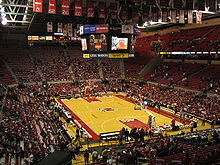 Comcast Center, home of Maryland basketball
Comcast Center, home of Maryland basketball
The university sponsors varsity athletic teams in 27 men's and women's sports. The teams, nicknamed the "Terrapins", represent Maryland in National Collegiate Athletic Association Division I competition. Maryland became a founding member of the Atlantic Coast Conference in 1952. As of December 2010, Maryland's athletic teams have been awarded 38 national championships by the NCAA, USILA, AIAW, and NCA.[86] In 2008 and 2010, The Princeton Review named the University of Maryland's athletic facilities the best in the nation.[87][88] The Terrapins nickname (often shortened to "Terps") was coined by former university president, football coach, and athletic director H. C. "Curly" Byrd in 1932.[89] The mascot is a diamondback terrapin named Testudo, which is Latin for "tortoise."[90] Since the early 20th century, the school athletic colors have been some combination of those on the Maryland state flag: red, white, black, and gold.[91]
 Byrd Stadium near capacity on game day
Byrd Stadium near capacity on game day
Men's basketball is one of the most popular sports at the university.[92] Long-time head coach Lefty Driesell began the now nationwide tradition of "Midnight Madness in 1971.[93] Beginning in 1989, alumnus Gary Williams revived the program, which was struggling in the wake of Len Bias's death and NCAA rules infractions. Williams led Maryland basketball to national prominence with two Final Four appearances, and in 2002, a national championship. On February 7, 2006, Gary Williams won his 349th game to surpass Driesell and became Maryland's all-time leader among basketball coaches. Maryland football is also popular at the university.[92] The Terrapins were awarded the national championship by the wire services in 1953, and in 1951, by several retroactive selectors. Maryland has secured eleven conference championships, including nine in the ACC, which ranks third most in the league. The Terrapins most recently won the ACC in 2001 under alumnus and head coach Ralph Friedgen.
Beyond the two "revenue sports," the university fields 25 other varsity teams. Maryland men's lacrosse remains one of the sport's top programs since its beginnings as a squad in 1865,[94] although it last won the national championship in 1975. The team has secured ten USILA and NCAA national championships since its promotion to varsity status in 1924, and is a regular fixture in the NCAA tournament.[95] The women's lacrosse team has the most national championships of any program in the nation, including most recently in 2010.[96] The women's basketball team rose to prominence in the 2000s, and head coach Brenda Frese guided the Lady Terps to their first NCAA title in 2006.[97] The men' soccer team has reached five Final Fours since 1997 under the guidance of head coach Sasho Cirovski, and captured the College Cup in 2005 and 2008.[98] The women's field hockey team has secured seven NCAA championships.[99] The Maryland wrestling team was dominant in the ACC throughout the 1950s and 1960s and returned to claim two more conference titles in the late 2000s.[100]
The Mighty Sound of Maryland marching band attends all home football games and provides pre-game performances.[101] During the basketball season, the marching band becomes the University of Maryland Pep Band, which provides music in the stands at men's and women's home games and during tournament play.[102]
Testudo
In 1932, Curley Byrd—who served as the university's football and baseball coach, athletic director, and president—proposed adopting the diamondback terrapin as a mascot. The first statue of Testudo cast in bronze was donated by the Class of 1933 and displayed on Baltimore Avenue in front of Ritchie Coliseum. However, the 300-pound sculpture was subjected to vandalism by visiting college athletic teams.[103] One such incident occurred in 1947 when students from Johns Hopkins University stole the bronze statue and moved it to their campus. Maryland students traveled to Baltimore to retrieve it, and laid siege to the house where it was hidden. Over 200 city police responded to quell the riot.[104] In 1949, University President Byrd was awakened by a phone call from a University of Virginia fraternity requesting that Testudo be removed from their lawn. Testudo was later filled with 700 pounds of cement and fastened to his pedestal to prevent future removals, but students at rival schools continued to vandalize it. It was moved to Byrd Stadium in 1951. In the 1960s, Testudo was moved back to a spot in front of McKeldin Library. Some passersby consider it good luck to rub the statue, which has given its nose a shiny appearance. During finals week, students traditionally leave "offerings" to the statue for good luck.[105][106][107][108]
In 1992 a duplicate statue was placed at Byrd Stadium, where the football team touch it for good luck as they pass by before games. Additional Testudo statues now sit outside of the Gossett Team House near the stadium; Comcast Center, the school's basketball arena; the Riggs Alumni Center; and in the lobby of the Adele H. Stamp Student Union.[107] In 1994, the Maryland General Assembly approved legislation to name the diamondback terrapin (malaclemys terrapin terrapin) as the official state reptile and the legally codified mascot of the University of Maryland.[109] Beginning in the 2000s, the university promoted the slogan, "Fear the Turtle" as a rallying cry for school pride.[110]
Notable people
Main articles: List of University of Maryland, College Park people and President of the University of Maryland, College ParkUniversity attendees have achieved fame or notability across a variety of disciplines. Famous alumni include physicist Jamal Nazrul Islam, former House Majority Leader Steny Hoyer; Google co-founder Sergey Brin; The Muppets creator Jim Henson; and Seinfeld producer Larry David. Prominent alumni in business include Jim Walton, President and CEO of CNN; Kevin Plank, founder of the athletic apparel company Under Armour; Chris Kubasik, President of Lockheed Martin; Carly Fiorina, former CEO of Hewlett-Packard; Telecommunications entrepreneur Brian Hinman, and Hamad Al Sayari, Former governor of the Saudi Arabian Central Bank(Saudi Arabia Monetary Agency).
Television personality Connie Chung; E! News reporter Giuliana Rancic graduated with a bachelors degree from the Philip Merrill College of Journalism. ESPN reporters Bonnie Bernstein, Tim Kurkjian, and Scott Van Pelt all graduated from the Philip Merrill College of Journalism. Journalist Carl Bernstein, who won the Pulitzer Prize for Public Service for his coverage of the Watergate scandal, attended the University but did not graduate. Kiran Chetry, co-host of CNN's American Morning, graduated with a bachelors of arts in broadcast journalism. Heidi Collins of CNN Newsroom graduated with a bachelors of science. Former Maryland governor Harry R. Hughes also attended. Gayle King, editor-at-large for O, The Oprah Magazine, graduated from Maryland with a degree in psychology.
Attendees within the fields of science and mathematics are: Nobel Laureates Raymond Davis Jr., 2002 winner in Physics; Herbert Hauptman, 1985 winner in Chemistry, and Fields Medal winner Charles Fefferman. Other alumni include George Dantzig, considered the father of linear programming; late NASA astronaut Judith Resnik, who died in the destruction of the Space Shuttle Challenger during the launch of mission STS-51-L; and NASA Administrator Michael D. Griffin.
Several donors have distinguished themselves for their sizable gifts to the University. Businessman Robert H. Smith, who graduated from the university in 1950 with a degree in accounting, has given over $45 million to the business school that now bears his name, and to the Clarice Smith Performing Arts Center, which bears his wife's name.[111] Construction entrepreneur A. James Clark, who graduated with an engineering degree in 1950, has also donated over $45 million to the college of engineering, which also bears his name.[111] Another engineering donor, Jeong H. Kim, earned his Ph.D. from the university in 1991 and gave $5 million for the construction of a state-of-the-art engineering building.[112] Philip Merrill, a media figure, donated $10 million to the College of Journalism.[113]
Filmography
The University of Maryland, College Park Campus has been featured in several films.
- National Treasure: Book of Secrets (2007)
- Life 101 (1995)
- St. Elmo's Fire (1985)
References
- ^ University of Maryland Libraries (2006-04-11). "MAC TO MILLENNIUM: Letter M". http://www.lib.umd.edu/univarchives/macmil/letm.html. Retrieved 2010-06-18.
- ^ Maryland State Archives (2005-04-21). "Maryland State Archives: Great Seal of Maryland". http://www.msa.md.gov/msa/mdmanual/01glance/html/symbols/reverse.html. Retrieved 2010-06-18.
- ^ "University of Maryland-College Endowment for 2010". January 29, 2011. http://www.nacubo.org/Documents/research/2010NCSE_Public_Tables_Endowment_Market_Values_Final.pdf. Retrieved 2011-01-29.
- ^ "Wallace D. Loh Appointed President of University of Maryland". University of Maryland, College Park. August 17, 2010. http://newsdesk.umd.edu/universitynews/release.cfm?ArticleID=2213. Retrieved 2010-08-30.
- ^ a b De Vise, Dan (August 17, 2010). "U-Md. names U. of Iowa provost as president". Washington Post: p. B1.
- ^ "The Provost, Office of the Provost, UMCP website". http://www.provost.umd.edu/about/wylie.cfm. Retrieved 6 June 2011.
- ^ a b c d e f g h Office of University Communications. "UM Newsdesk: Quick Facts". Quick Facts. http://www.newsdesk.umd.edu/facts/quickfacts.cfm. Retrieved 2010-12-23.
- ^ National Center for Education Statistics (2010). "Enrollment of the 120 largest degree-granting college and university campuses, by selected characteristics and institution: Fall 2008". http://nces.ed.gov/programs/digest/d10/tables/dt10_235.asp. Retrieved 2010-12-23.
- ^ Maryland State Archives (2010-06-18). "University of Maryland, College Park - Budget". http://www.msa.md.gov/msa/mdmanual/25univ/umcp/html/umcpb.html. Retrieved 2010-06-18.
- ^ "MD's 2 Top Public Universities Surpass $1 Billion in Combined Research Funding :: University Communications Newsdesk, University of Maryland". Newsdesk.umd.edu. 2009-10-01. http://www.newsdesk.umd.edu/uniini/release.cfm?ArticleID=1981. Retrieved 2010-05-08.
- ^ University Relations. "Great Expectations, The Campaign for Maryland". http://www.greatexpectations.umd.edu/. Retrieved 2011-03-17.
- ^ a b c d e f g h i "University of Maryland Timeline". http://www.urhome.umd.edu/timeline/. Retrieved 2010-06-18.
- ^ United States Department of Agriculture (2010-01-21). "Morrill Land Grant College Act : History, Art and Biography : National Agricultural Library". http://riley.nal.usda.gov/nal_display/index.php?info_center=8&tax_level=4&tax_subject=3&topic_id=1030&level3_id=6723&level4_id=11088. Retrieved 2010-06-18.
- ^ Durgin, Teddy Well-schooled:What you may not know about Maryland's colleges and universities The Baltimore Sun. September 30, 2003.
- ^ Prince George's County Historical Society (1996). "Prince George's County Tricentennial". Civil War. http://www.pghistory.org/PG/PG300/civilwar.html. Retrieved 2010-06-18.
- ^ "Brigadier General (Dr.) Herbert V. Swindell". U.S. Air Force. April 1979. http://www.af.mil/information/bios/bio.asp?bioID=7319. Retrieved September 29, 2011.
- ^ http://www.blackpast.org/?q=aah/university-maryland-eastern-shore-1887
- ^ The Baltimore Sun (May 19, 1970). "U. of M. Calm as Curfew is Enforced; Mandel Vows To Back 300 Guardsmen With 9,700 More". http://pqasb.pqarchiver.com/baltsun/access/1759250652.html?FMT=ABS&FMTS=ABS:AI&type=historic&date=May+19%2C+1970&author=&pub=The+Sun+%281837-1985%29&desc=U.+OF+M.+CALM+AS+CURFEW+IS+ENFORCED&pqatl=google. Retrieved 2010-08-07.
- ^ Office of University Communications. "University of Maryland Identity Guide". http://www.newsdesk.umd.edu/media/identityguide.pdf.
- ^ Associated Press (2001-09-25). "Tornado kills two, damages University of Maryland". USA Today. http://www.usatoday.com/weather/news/2001/2001-09-24-dc-twister.htm. Retrieved 2010-06-18.
- ^ University of Maryland Libraries (2006-04-11). "MAC TO MILLENNIUM: Letter C". http://www.lib.umd.edu/univarchives/macmil/letc.html. Retrieved 2010-06-18.
- ^ "M Square Research Park, University of Maryland". Msquare.umd.edu. http://www.msquare.umd.edu/. Retrieved 2010-06-26.
- ^ Hernandez, Nelson (2006-10-21). "U-Md. Aims to Boost Student Aid, Affordability - washingtonpost.com". Washington Post. http://www.washingtonpost.com/wp-dyn/content/article/2006/10/20/AR2006102001401.html. Retrieved 2010-06-18.
- ^ University of Maryland. "Strategic Plan, Office of the Provost, University of Maryland". http://www.provost.umd.edu/implement.cfm. Retrieved 2010-06-18.
- ^ Ottalini, David (2007-09-25). "Birchmere To Open New Music Hall in College Park". http://www.newsdesk.umd.edu/uniini/release.cfm?ArticleID=1506. Retrieved 2010-06-18.
- ^ Tune, Lee. "Top Officials Cite Importance of Planned UM Physical Sciences Complex". http://www.newsdesk.umd.edu/scitech/release.cfm?ArticleID=2165. Retrieved 2010-06-18.
- ^ Shaver, Katherine (2008-01-22). "U-Md. Wants Purple Line Off Its Main Street". The Washington Post (College Park, Md.). ISSN 0740-5421. http://www.washingtonpost.com/wp-dyn/content/article/2008/01/21/AR2008012102159.html?hpid=moreheadlines. Retrieved 2010-06-18.
- ^ Hill, David (2010-05-27). "UM wants underground tunnel for Purple Line". The Gazette. http://www.gazette.net/stories/05272010/collnew182959_32547.php. Retrieved 2010-06-18.
- ^ http://www.ugst.umd.edu/core/overview/GenerEd.html
- ^ http://greek.umd.edu/wp-content/uploads/2010/10/All-Chapter-Averages-Spring-2010.pdf
- ^ University of Maryland. "Honors College University of Maryland". http://www.honors.umd.edu/overview.php. Retrieved 2010-06-18.
- ^ About Gemstone, Clark School of Engineering, Engineering, University of Maryland
- ^ Honors Humanities :: Home
- ^ University of Maryland, College Park Scholars (2010). "College Park Scholars". http://www.scholars.umd.edu/about/. Retrieved 2010-06-18.
- ^ UMD Hinman CEOs
- ^ Robert H. Smith School of Business. "QUEST - Robert H. Smith School of Business - University of Maryland, College Park". http://www.rhsmith.umd.edu/quest/. Retrieved 2010-06-18.
- ^ University of Maryland (2009-12-15). "CIVICUS Living and Learning Program". http://www.civicus.umd.edu/home.htm. Retrieved 2010-06-18.
- ^ Office of Undergraduate Studies. "Global Communities - University of Maryland". http://www.globalcommunities.umd.edu/. Retrieved 2010-06-18.
- ^ Liu, Phoenix. "The Language House Website". http://www.languages.umd.edu/lh/. Retrieved 2010-06-18.
- ^ "M Square Research Park, University of Maryland". http://www.msquare.umd.edu/. Retrieved 2010-06-18.
- ^ Ottalini, David (2003-07-05). "Maryland Wins NIH Training Grant". http://www.newsdesk.umd.edu/culture/release.cfm?ArticleID=752. Retrieved 2010-06-18.
- ^ University of Maryland (2010). "Clark School Leads NASA Project". http://www.aero.umd.edu/news/news_story.php?id=2477. Retrieved 2010-06-18.
- ^ START | About START
- ^ Ternes, Ellen (2005-01-20). "UM to Head National Avian Flu Research Project". http://www.newsdesk.umd.edu/scitech/release.cfm?ArticleID=1027. Retrieved 2010-06-18.
- ^ "University of Maryland--College Park - Best Colleges - Education - US News and World Report". http://colleges.usnews.rankingsandreviews.com/best-colleges/college-park-md/university-of-maryland-2103/@@Admissions_overview.html. Retrieved 2010-06-18.
- ^ Office of Undergraduate Admissions (2009). "University of Maryland - Apply, Undergraduate Admissions, University of Maryland". http://www.admissions.umd.edu/admissions/apply/default.asp. Retrieved 2010-06-18.
- ^ "National Universities Rankings". America's Best Colleges 2012. U.S. News & World Report. September 13, 2011. http://colleges.usnews.rankingsandreviews.com/best-colleges. Retrieved September 25, 2011.
- ^ "The Washington Monthly National University Rankings". The Washington Monthly. 2011. http://www.washingtonmonthly.com/college_guide/rankings_2011/national_university_rank.php. Retrieved August 30, 2011.
- ^ "Academic Ranking of World Universities: Global". Institute of Higher Education, Shanghai Jiao Tong University. 2011. http://www.shanghairanking.com/ARWU2011.html. Retrieved August 30, 2011.
- ^ "QS World University Rankings". QS Quacquarelli Symonds Limited. 2011. http://www.topuniversities.com/university-rankings/world-university-rankings/2011. Retrieved September 30, 2011.
- ^ "Top 400 - The Times Higher Education World University Rankings 2011-2012". The Times Higher Education. 2011. http://www.timeshighereducation.co.uk/world-university-rankings/2011-2012/top-400.html. Retrieved October 6, 2011.
- ^ National Universities: Top Schools
- ^ University of Maryland Facts and Figures: 2007 University Rankings
- ^ Times Higher Education - QS World University Rankings 2007 - Top 100 Universities
- ^ http://www.topuniversities.com/university-rankings/world-university-rankings/2011?page=2
- ^ O'Connell, Kim A.. "Profile: University of Maryland School of Architecture". Traditional-building.com. http://www.traditional-building.com/Previous-Issues-06/AprilProfile06.html. Retrieved 2010-06-26.
- ^ "Mac To Millennium: Letter C". Lib.umd.edu. http://www.lib.umd.edu/univarchives/macmil/letc.html. Retrieved 2010-06-26.
- ^ a b UM University Visitors Network, Arboretum and Botanical Garden.. Retrieved 2010-6-18.
- ^ Arbor Day Foundation website, List of Tree Campus USA Schools. Retrieved 2010-6-18.
- ^ http://www.dnr.state.md.us/greenways/counties/princegeorges.html Maryland Atlas of Greenways, Water Trails, and Green Infrastructure Retrieved 2010-7-1.
- ^ "Campus Drive Pilot". Facilities.umd.edu. http://www.facilities.umd.edu/CampusDrive/. Retrieved 2010-06-26.
- ^ Ottalini, David (2001-09-25). "Jim Henson Statue and Memorial Garden Media Kit :: University Communications Newsdesk, University of Maryland". http://www.newsdesk.umd.edu/archive/release.cfm?year=2003&ArticleID=773. Retrieved 2010-06-18.
- ^ "Mac To Millennium: Letter M". Lib.umd.edu. http://www.lib.umd.edu/univarchives/macmil/letm.html. Retrieved 2010-06-26.
- ^ "The Rossborough Inn Marker". Hmdb.org. http://www.hmdb.org/Marker.asp?Marker=13163. Retrieved 2010-06-26.
- ^ "Mac To Millennium: Letter G". Lib.umd.edu. http://www.lib.umd.edu/univarchives/macmil/letg.html. Retrieved 2010-06-26.
- ^ "UM Sustainability Snapshot". University of Maryland. http://www.sustainability.umd.edu/index.php?p=sustain_snapshot. Retrieved 2009-06-08.
- ^ Get your FREE! Nation User Name (2007-11-15). "Climate Change Power Shift". The Nation. http://www.thenation.com/article/climate-change-power-shift. Retrieved 2010-06-26.
- ^ "About Merrill | Philip Merrill College of Journalism". Merrill.umd.edu. 2006-05-18. http://www.merrill.umd.edu/about/about. Retrieved 2010-06-26.
- ^ Hartnett, Herb (2010-04-20). "UM Among Princeton Review's Green Colleges". http://www.newsdesk.umd.edu/undergradexp/release.cfm?ArticleID=2141. Retrieved 2010-06-18.
- ^ Cetrone, Dana (2010-02-24). "New solar panels on Diner’s roof should save $1.7M nnually". The Diamondback. http://www.diamondbackonline.com/news/new-solar-panels-on-diner-s-roof-should-save-1-7m-annually-1.1171761. Retrieved 2010-06-18.
- ^ http://www.hdrcuh2a.com/#/Our%20Work/Academic/Physical%20Science%20Complex.aspx?GUID=99BE41F9-73A3-42B9-A03B-0381758B19F0
- ^ "Physical Sciences Complex | CMPS". Cmps.umd.edu. http://www.cmps.umd.edu/psc.htm. Retrieved 2010-06-26.
- ^ Romas, Maria. "No place for children." The Diamondback. Friday March 18, 2011. Retrieved on October 3, 2011.
- ^ "Department of Transportation Services - University of Maryland". Transportation.umd.edu. 2009-07-01. http://www.transportation.umd.edu/parking.html. Retrieved 2010-06-26.
- ^ "Department of Transportation Services - University of Maryland". Transportation.umd.edu. 2009-04-01. http://www.transportation.umd.edu/alt_trans/zipcar.html. Retrieved 2010-06-26.
- ^ "The Diamondback - Cyclists say bike safety week just first step". Diamondbackonline.com. 2010-04-09. http://www.diamondbackonline.com/news/cyclists-say-bike-safety-week-just-first-step-1.1312815. Retrieved 2010-06-26.
- ^ "The Diamondback - Bicycle-sharing program set to begin pilot this semester". Diamondbackonline.com. 2009-09-16. http://www.diamondbackonline.com/news/bicycle-sharing-program-set-to-begin-pilot-this-semester-1.474372. Retrieved 2010-06-26.
- ^ "The Diamondback - As DOTS pushes biking, gender gap persists". Diamondbackonline.com. 2009-12-13. http://www.diamondbackonline.com/news/as-dots-pushes-biking-gender-gap-persists-1.985909. Retrieved 2010-06-26.
- ^ Shaver, Katherine (2008-01-22). "U-Md. Wants Purple Line Off Its Main Street". washingtonpost.com. http://www.washingtonpost.com/wp-dyn/content/article/2008/01/21/AR2008012102159.html?hpid=moreheadlines. Retrieved 2010-06-26.
- ^ "UM wants underground tunnel for Purple Line". Gazette.net. 2010-05-27. http://www.gazette.net/stories/05272010/collnew182959_32547.php. Retrieved 2010-06-26.
- ^ Amicus brief in Rossignol v. Voorhaar, May 30, 2005, retrieved July 9, 2010.
- ^ Society of Professional Journalists: Mark of Excellence Awards
- ^ Society of Professional Journalists: Mark of Excellence Awards
- ^ College Board profile of the University of Maryland, College Park
- ^ http://greek.umd.edu/councils-and-groups/
- ^ National Championships, University of Maryland. Retrieved June 16, 2010.
- ^ Maryland colleges get high and low marks on Princeton Review study, Baltimore Business Journal, August 1, 2008. Retrieved June 16, 2010.
- ^ Best Colleges Press Release, The Princeton Review, August 2, 2010, retrieved August 28, 2010.
- ^ CollegeFootballHistory.com. "Maryland Terrapins History - College Football". http://www.collegefootballhistory.com/maryland/history.htm. Retrieved 2010-07-09.
- ^ Testudo, Merriam Webster. Retrieved June 16, 2010.
- ^ School Colors, University of Maryland. Retrieved June 18, 2010.
- ^ a b University of Maryland College Prowler Off the Record, p. 84–86, 2005, ISBN 1-59658-160-3.
- ^ Landman, Brian (2006-10-13). "Sports: He made midnight a time for madness". St. Petersburg Times. http://www.sptimes.com/2006/10/13/Sports/He_made_midnight_a_ti.shtml. Retrieved 2010-06-18.
- ^ Craats, Rennay (2002). Maryland. Mankato MN: Weigl Publishers. p. 26. ISBN 9781590360002.
- ^ "The Official Website of NCAA Championships - History". NCAA.com. http://www.ncaa.com/history/m-lacrosse-d1.html. Retrieved 2010-05-08.
- ^ "Women's Lacrosse: Maryland captures first NCAA title since 2001 with 13-11 win over Northwestern". 2010-05-30. http://insidelacrosse.com/news/2010/05/30/womens-lacrosse-maryland-captures-first-ncaa-title-2001-with-13-11-win-over. Retrieved 2010-06-18.
- ^ "Maryland Athletics - University of Maryland Official Athletic Site - Women's Basketball". Umterps.com. 2009-03-08. http://www.umterps.com/sports/w-baskbl/recaps/030809aaa.html. Retrieved 2010-05-08.
- ^ "Maryland Men's Soccer: NCAA Tournament History". http://www.umterps.com/sports/m-soccer/history/ncaa_history.html. Retrieved 2010-12-06.
- ^ "Maryland Field Hockey: 2010 National Champions". 2010-11-22. http://www.umterps.com/sports/w-fieldh/2010_champions/. Retrieved 2010-12-06.
- ^ Wrestling: Year-by-Year Results, University of Maryland. Retrieved June 16, 2010.
- ^ "Mighty Sound of Maryland" Marching Band
- ^ Basketball Pep Band
- ^ Testudo: Tale of the Top Shell, University of Maryland. Retrieved June 8, 2009.
- ^ Lee, Edward (2010-04-11). "Catalino, Reed lead No. 5 Terps past No. 20 Mids - Baltimore Sun". Baltimore Sun (College Park, Md.). http://articles.baltimoresun.com/2010-04-11/sports/bal-sp.terpslax11apr11_1_grant-catalino-midshipmen-terps-sophomore-attackman. Retrieved 2010-06-18.
- ^ "Traditions at The University of Maryland". Umd.edu. 1933-05-23. http://www.umd.edu/traditions/testudo/. Retrieved 2010-06-26.
- ^ "Traditions at The University of Maryland". Umd.edu. 2003-09-24. http://www.umd.edu/traditions/landmarks/. Retrieved 2010-06-26.
- ^ a b "Mac To Millennium: Testudo". Lib.umd.edu. http://www.lib.umd.edu/univarchives/macmil/testudo.html. Retrieved 2010-06-26.
- ^ Rasmussen, Frederick (2002-03-23). "A stroke of good luck in Terps sculpture - Baltimore Sun". Baltimore Sun. http://articles.baltimoresun.com/2002-03-23/features/0203230044_1_mckeldin-library-nose-university-of-maryland. Retrieved 2010-06-18.
- ^ Maryland State Archives (2010-03-08). "Diamondback Terrapin, Maryland State Reptile". http://www.mdgovpap.net/msa/mdmanual/01glance/symbols/html/reptile.html. Retrieved 2010-06-18.
- ^ "Fear the Turtle! University of Maryland". University of Maryland. Archived from the original on 2007-08-09. http://web.archive.org/web/20070809225009/http://www.feartheturtle.umd.edu/about/. Retrieved 2008-02-08.
- ^ a b Robert H. Smith School of Business to Share in University of Maryland Gifts Totaling $60 Million
- ^ Pearlstein, Steven (2005-09-21). "Steven Pearlstein - Economic Recycling Enlarges U-Md.'s Engineering School". The Washington Post. ISSN 0740-5421. http://www.washingtonpost.com/wp-dyn/content/article/2005/09/20/AR2005092001828.html. Retrieved 2010-06-18.
- ^ Fisher, Marc (2006-06-13). "Phil Merrill and the Vanishing Iconoclastic Publishers". Raw Fisher. http://blog.washingtonpost.com/rawfisher/2006/06/phil_merrill_and_the_vanishing.html. Retrieved 2010-06-18.
External links
University of Maryland, College Park Academics A. James Clark School of Engineering · College of Agriculture and Natural Resources · School of Architecture, Planning, and Preservation · College of Arts and Humanities · College of Behavioral and Social Sciences · College of Computer, Mathematical, and Natural Sciences · College of Education · College of Information Studies · Philip Merrill College of Journalism · Robert H. Smith School of Business · School of Music · School of Public Health · School of Public Policy · College Park Scholars

Athletics Teams: Baseball · Football · Men's basketball · Men's lacrosse · Men's soccer · Women's basketball · Women's lacrosse
Facilities: Comcast Center · Byrd Stadium · Cole Field House · Shipley Field · Ludwig Field · Golf Course · Taylor Stadium · Ritchie Coliseum · Old Byrd Stadium
Rivalries: Duke · Johns Hopkins · Navy · Penn State · Virginia · West Virginia
University of Maryland Athletic Hall of Fame · Midnight MadnessCampus Landmarks: Adele H. Stamp Student Union · "M" Circle · McKeldin Mall · Memorial Chapel · Morrill Hall · The Rossborough Inn
Arts and Recreation: Arboretum & Botanical Garden · The Art Gallery · Clarice Smith Performing Arts Center · Observatory · Tawes Theatre
Facilities: Libraries · Security Operations Center
Transportation: Shuttle-UM · College Park – University of Maryland (WMATA station)People Student life Student Groups: List of student organizations · Greek life · Mighty Sound of Maryland · Monarchy Party
Media: Capital News Service · The Diamondback · UMTV · WMUC-FMPublic Institutions Biotechnology Institute · Bowie State · Center for Environmental Science · Coppin State · Frostburg State · Morgan State · Naval Academy · St. Mary's · Salisbury · Towson · University of Baltimore · University of Maryland, Baltimore · UMBC · University of Maryland, College Park · UMES · UMUC · USM at Hagerstown
Private Institutions Baltimore International · Capitol · Goucher · Griggs · Hood · Johns Hopkins · Labor · Loyola · MBCS · MICA · McDaniel · Mt. St. Mary's · Ner Israel · Notre Dame · St. John's · St. Mary's Seminary · Sojourner-Douglass · Stevenson · Washington · Washington Adventist
Community Colleges Allegany · Anne Arundel · Baltimore City · Baltimore County · Carroll · Cecil · Chesapeake · Frederick · Garrett · Hagerstown · Harford · Howard · Montgomery · Prince George's · Southern Maryland · Wor-Wic
Defunct Institutions Baltimore Hebrew University · Eastern Christian College · Mount Saint Agnes College · St. Charles College · Woodstock CollegeAtlantic Coast Conference Atlantic Division Boston College Eagles • Clemson Tigers • Florida State Seminoles • Maryland Terrapins • North Carolina State Wolfpack • Wake Forest Demon Deacons
Coastal Division Future members Pittsburgh Panthers (TBA) • Syracuse Orange (TBA)
Championships & awards Conference champions • National championships • Athlete of the Year
Association of American Universities (AAU) Public - Arizona
- University of California
- Colorado
- Florida
- Georgia Tech
- Illinois
- Indiana
- Iowa
- Iowa State
- Kansas
- Maryland
- Michigan
- Michigan State
- Minnesota
- Missouri
- State University of New York
- North Carolina
- Ohio State
- Oregon
- Penn State
- Pittsburgh
- Purdue
- Rutgers
- Texas
- Texas A&M
- Virginia
- Washington
- Wisconsin
Private Canadian Universities Research Association United States - Alabama
- Arizona
- Arizona State
- Boston University
- Brown
- Buffalo
- University of California
- Caltech
- Carnegie Mellon
- Case Western Reserve
- Chicago
- Colorado
- Columbia
- Cornell
- Duke
- Florida
- Florida State
- Harvard
- Hawaii
- Houston
- IIT
- Illinois at Urbana–Champaign
- Illinois at Chicago
- Indiana
- Iowa
- Iowa State
- Johns Hopkins
- LSU
- Maryland
- MIT
- Michigan
- Michigan State
- Minnesota
- Nebraska
- New Mexico
- New Mexico State
- North Carolina
- North Texas
- Northeastern
- Northern Illinois
- Northwestern
- Notre Dame
- Ohio State
- Oklahoma
- Oregon
- Penn State
- Pittsburgh
- Princeton
- Purdue
- Rice
- Rochester
- Rockefeller
- Rutgers
- SMU
- South Carolina
- Stanford
- Stony Brook
- Syracuse
- Tennessee
- University of Texas
- Texas A&M
- Texas Tech
- Tufts
- Tulane
- Utah
- Vanderbilt
- Virginia
- Virginia Tech
- Washington
- Washington University
- Wayne State
- William & Mary
- Wisconsin
- Yale
International Categories:- Association of American Universities
- University of Maryland, College Park
- Association of Public and Land-Grant Universities
- College Park, Maryland
- Land-grant universities and colleges
- Universities and colleges in Prince George's County, Maryland
- Schools of public health in the United States
- Educational institutions established in 1856
- Oak Ridge Associated Universities
- Forestry education
- Flagship universities in the United States
Wikimedia Foundation. 2010.

